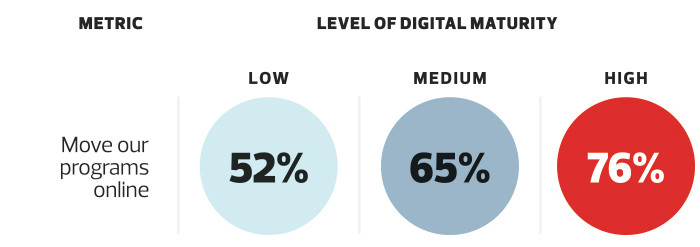Nonprofit organizations that are more digitally mature have fared much better during the pandemic than their less sophisticated peers, according to research by Salesforce. When it came to adapting programs to remote environments during mandated social distancing, those that were already reporting high rates of digital maturity managed far more easily than those that didn’t.
Defining digital maturity as an organization’s “ability to leverage data to inform decision-making, reach new audiences, personalize communications, and forecast fundraising income,” Salesforce partnered with the Urban Institute to survey 867 nonprofits in the United States, Canada and Europe, asking them to self-report their level of maturity in those terms, on a scale of 1 to 5. The survey included nonprofits of all sizes, but most were small, with 66 percent reporting annual revenue of $5 million or less. The result is the third edition of the Nonprofit Trends Report.
“We found that there was a connection between the organizations with high digital maturity and those with the most innovative and confident responses to change,” Salesforce says. “In an increasingly digital world, it’s more important than ever for nonprofits to have the modern digital tools necessary to be efficient, effective, and successful.”
Get the latest digital trends by following the right industry leaders. Click the banner below for this year's Influencer List.
For Nonprofits, Digital Maturity Delivers Resilience
About 71 percent of nonprofits are rated as “medium” on Saleforce’s Digital Maturity Index, meaning they self-reported average scores between 3 and 4.5. The rest are split almost evenly between low- and high-maturity organizations. The survey revealed stark differences between these nonprofits when it came to their resilience through the challenges of the pandemic.
For example, of the 16 percent of nonprofits that reported having high digital maturity, more than three-quarters said that when the pandemic struck in the first quarter of 2020, they were ready to move their programs online, compared with 52 percent of low-maturity organizations.
Many nonprofits are accustomed to delivering their services in person, but more than 71 percent of high-maturity organizations successfully developed “new methods” to deliver services; less than half of their low-maturity peers could do the same.
Fundraising and awareness-raising events are critical to nonprofits’ survival. When the pandemic forced them to figure out a way to shift their events online, many low-maturity organizations couldn’t; high-maturity nonprofits, on the other hand, fared much better.
Striking differences between high- and low-maturity nonprofits were seen in other key performance metrics as well. For example, three-quarters of high-maturity organizations were “prepared with the technologies we needed to help navigate the shifts in our operations” when the pandemic struck, compared with just 35 percent of low-maturity nonprofits.
Digitally Mature Nonprofits Are Better Positioned for the Future
Beyond simply surviving the pandemic, digitally mature nonprofits are much better positioned for long-term success, according to the report. For example, more than twice as many mature organizations as other nonprofits express optimism that they’ll be able to grow major and planned donations in the coming months.
Meanwhile, the majority of mature nonprofits — but minorities of all other nonprofits — say they will succeed in the following areas in the coming years:
- Engaging more with audiences through digital channels (56 percent compared with 39 percent)
- Personalizing how they serve the recipients of their services (56 percent compared with 42 percent)
- Better engaging volunteers (58 percent compared with 48 percent)
- Having stronger capabilities in online donations (53 percent compared with 44 percent)
“The clear correlation between the organizations with high digital maturity and those with the most positive response rates illustrates the digital imperative for nonprofits,” the report states. “Leading organizations were significantly more likely to exceed their goals, even during the pandemic. Digitally mature nonprofits were also better able to understand their environment and plan for the future. Higher digital maturity among nonprofits is associated with success and confidence, even amidst rapid and unprecedented change. Leading nonprofits were less anxious about financial viability, less concerned about retaining staff, and less uncertain about making long-term impact.”















